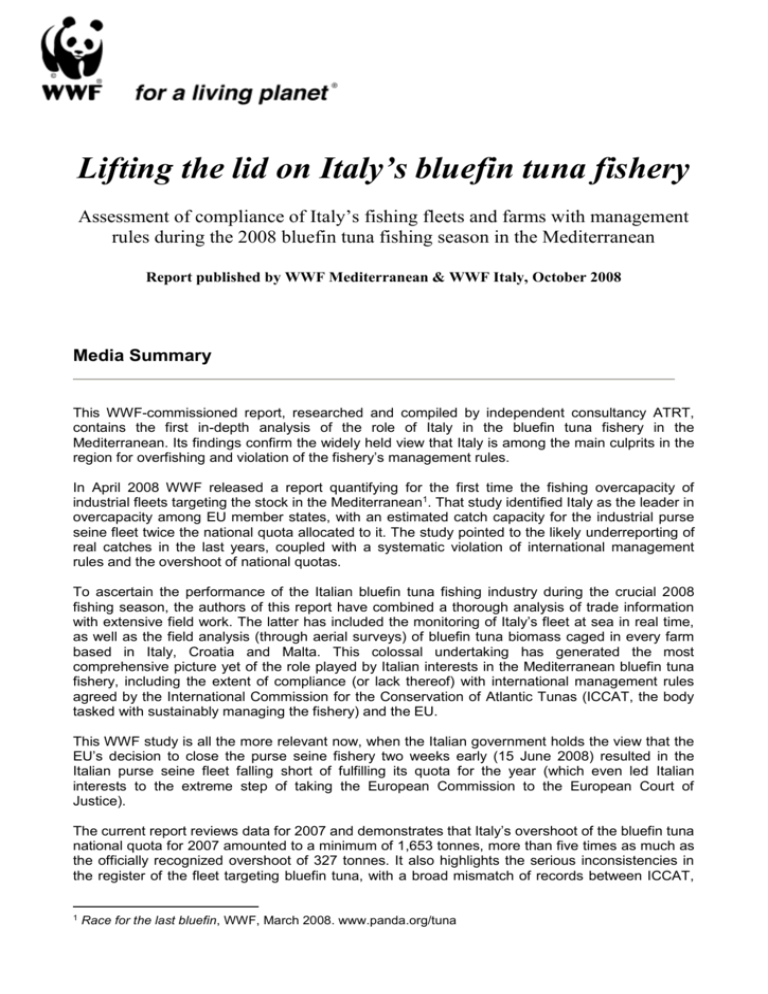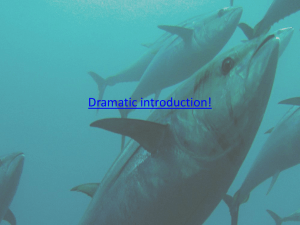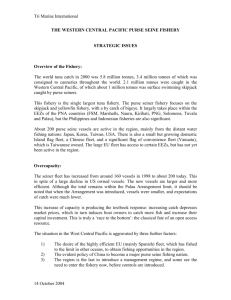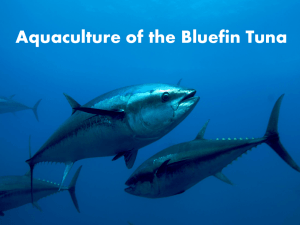Lifting the lid on Italy`s bluefin tuna fishery Assessment of
advertisement

Lifting the lid on Italy’s bluefin tuna fishery Assessment of compliance of Italy’s fishing fleets and farms with management rules during the 2008 bluefin tuna fishing season in the Mediterranean Report published by WWF Mediterranean & WWF Italy, October 2008 Media Summary This WWF-commissioned report, researched and compiled by independent consultancy ATRT, contains the first in-depth analysis of the role of Italy in the bluefin tuna fishery in the Mediterranean. Its findings confirm the widely held view that Italy is among the main culprits in the region for overfishing and violation of the fishery’s management rules. In April 2008 WWF released a report quantifying for the first time the fishing overcapacity of industrial fleets targeting the stock in the Mediterranean1. That study identified Italy as the leader in overcapacity among EU member states, with an estimated catch capacity for the industrial purse seine fleet twice the national quota allocated to it. The study pointed to the likely underreporting of real catches in the last years, coupled with a systematic violation of international management rules and the overshoot of national quotas. To ascertain the performance of the Italian bluefin tuna fishing industry during the crucial 2008 fishing season, the authors of this report have combined a thorough analysis of trade information with extensive field work. The latter has included the monitoring of Italy’s fleet at sea in real time, as well as the field analysis (through aerial surveys) of bluefin tuna biomass caged in every farm based in Italy, Croatia and Malta. This colossal undertaking has generated the most comprehensive picture yet of the role played by Italian interests in the Mediterranean bluefin tuna fishery, including the extent of compliance (or lack thereof) with international management rules agreed by the International Commission for the Conservation of Atlantic Tunas (ICCAT, the body tasked with sustainably managing the fishery) and the EU. This WWF study is all the more relevant now, when the Italian government holds the view that the EU’s decision to close the purse seine fishery two weeks early (15 June 2008) resulted in the Italian purse seine fleet falling short of fulfilling its quota for the year (which even led Italian interests to the extreme step of taking the European Commission to the European Court of Justice). The current report reviews data for 2007 and demonstrates that Italy’s overshoot of the bluefin tuna national quota for 2007 amounted to a minimum of 1,653 tonnes, more than five times as much as the officially recognized overshoot of 327 tonnes. It also highlights the serious inconsistencies in the register of the fleet targeting bluefin tuna, with a broad mismatch of records between ICCAT, 1 Race for the last bluefin, WWF, March 2008. www.panda.org/tuna the EU and national fleet registers. Up to 163 purse seine vessels would have been active in the Mediterranean bluefin tuna fishery in 2008, according to the crosscheck between the relevant official registers. A total of 15 purse seine flotillas, or fishing groupings, were identified to be operating during the 2008 fishing season, including in partnership with other Libyan, Turkish and possibly Algerian vessels. The latter were identified as having been involved in an illegal operation of paper-quota transfer between Algerian and Turkish vessels during the 2008 fishing season. The report includes extensive field information proving that Italian airports have played a key role during 2008 as a hub for illegal aerial spotting activities in central Mediterranean waters. Additionally, Italian spotter planes have operated (with others, such as US, French and Swiss) in support of the illegal activities of Italian purse seiners. A total of 5 farms based in Italy were identified as active in 2008, containing an estimated biomass of 2,410 tonnes of live tuna (equivalent to an estimated weight at input of 2,241 tonnes). This tuna was caught exclusively by Italian purse seiners operating during the 2008 fishing season. Additionally, a conservative 1,321 tonnes of bluefin tuna is estimated to have been caught by Italian purse seiners in the early spring fishery inside the Adriatic Sea, including an estimate of 853 tonnes that would have been caged in Croatian farms. Finally, a further 1,159 tonnes of tuna are estimated to have been caught by Italian seiners and transferred to farms in Malta and Tunisia during 2008. The estimate of the total bluefin tuna catch by Italian fleets during the 2008 fishing season contained in WWF’s report thus amounts to 4,887 tonnes at the very minimum. This highly conservative figure does not account for any estimate of catches by long line fleets outside of the Adriatic Sea, due to the impossibility of obtaining this information, and yet, entails a minimum quota overshoot by Italy of 724 tonnes. One wonders what the final catch of Italy’s bluefin tuna fleet might have been, had the EU not closed the purse seine fishery 15 days earlier than initially scheduled this year. Additionally, the report highlights that several relevant fishing ports for bluefin tuna in Italy, such as Pozzuoli, Vibo Valentia, Portopalo and Cetraro, are duly registered with ICCAT as landing ports for the species, but do not report any single bluefin tuna. In WWF’s opinion, the disturbing findings of this report (concerning a significant EU member state) reinforce the conclusions contained in the recent independent verdict on ICCAT’s performance elaborated by an international panel of experts2, released in September 2008. The report commissioned by ICCAT describes mismanagement in the East Atlantic and Mediterranean bluefin tuna fishery as an “international disgrace” and recommends that ICCAT immediately suspend fishing – until conditions for sustainable fisheries management exist. WWF continues to advocate a moratorium of the fishery – and in parallel encourages retailers, chefs, restaurants and consumers to join the growing boycott of the species – until Mediterranean bluefin tuna has been pulled safely back from the brink. 2 Report of the independent review ICCAT. G.D. Hurry, M. Hayashi & J.J. Maguire, September 2008. www.iccat.int Key findings of WWF report WWF’s report Lifting the lid on Italy’s bluefin tuna fishery reveals: 1. Italy overshot its TAC by 38% in 2007 Italy’s 2007 BFT EU TAC overshot amounted to a minimum of 1,653 tonnes, that is a 38.15% of its allocated quota for that year, as opposed to Italy’s official 327 tonnes 2007 overshot stated by Brussels. Italy’s massive 5,990 tonnes catch in 2007 constituted of catches according to ICCAT statistical reports, unaccounted Italian caught and ranched BFT estimates, Italian 2007 caught processed BFT exports according to trade statistics, and Italian 2007 caught BFT traded fresh at Italian main fish markets during 2007. 2. Despite the early closure of the fishery, Italy overshot its 2008 TAC by 724 tonnes Despite the closure of the BFT fishery by the EU on June 15, 2008, and the consequent allegations by the Italian industry and government that the EU’s decision to close the purse seine fishery two weeks early resulted in the Italian purse seine fleet falling short of fulfilling its quota for the year, the current report discloses that after summing the amounts of BFT fished, sold and exported from all sources and by all gears in 2008, Italy overshot its TAC by at least 724 tonnes, with a total 2008 catch estimate of 4,887 tonnes. 3. More than 4.000 tonnes of 2008 caught tuna transferred live into Italian, Tunisian, Maltese and Croatian farms Aerial surveys for the current report showed an estimated 2,410 tonnes of live tuna (equivalent to an estimated weight at input of 2,241 tonnes) in the 5 operational Italian farms, which would have all been caught in the 2008 fishing season by Italian purse seine vessels. Further, on-site surveys and industry reports show that a further 839 and 320 tonnes of tuna were transferred live into tuna cages in Malta and Tunisia respectively. Finally, records indicate that at least 853 tonnes would have been caught and transferred into Croatian farms by Italian vessels. The total amount of BFT thus likely to have been fished by Italian purse seine vessels for transfer into tuna farms is 4,253 tonnes, which in itself exceeds Italy’s 2008 TAC. 4. Italy a hub for illegal BFT spotter planes in the Mediterranean BFT fishing companies have notoriously used BFT spotter planes in the past and have also done so in the 2008 BFT fishing season, despite a strict ban against this since 2006. Italy has acted as a hub for such activity, allowing a number of foreign registered aircrafts to fly for Italian BFT fishing companies or for foreign BFT purse seine vessels operative in the Central Mediterranean. Further, a number of Italian landing strips and airports have been used by Italian and foreign registered illegal tuna-spotting aircrafts as launch pads for those aircrafts to fly out of the EU airspace into Libya, Tunisia and Egypt, where as in Italy, authorities deliberately refuse to fully enforce ICCAT’s rulings. The airports of Lampedusa, Pantelleria, and Marina di Modica have been particularly frequently used by illegal spotter planes. 5. Italian fleet statistics are a nightmare According to the EC Fleet Register (CFR), 611 vessels are registered with ICCAT, yet of these, only 103 are registered as active BFT fishing vessels, and only 82 as active in BFT ranching. However, after a series of cross checks, the total number of flagged vessels identified as positively or probably having been directly involved in BFT fishing and ranching during the 2008 BFT fishing season inside the Mediterranean Sea in this report amounted to 283 units, of which 27 are longliners, 162 purse seiners, 73 trawlers and 21 tugboats, a sum much higher than official records showed. Of these, 47 vessels were not equipped with vessel monitoring systems; 160 did not have BFT fishing licenses; and 82 vessels were unregistered to ICCAT in 2008. 6. Italian purse seine fleets structure themselves into vessel groupings or flotillas Italian BFT purse seine vessels often team-up into small groups called flotillas. After considerable on-site research, 15 flotillas were identified: 2 operating in the Northern Adriatic Sea, 2 in the Central Adriatic Sea, 3 operative in the Ionian Sea, 6 operative in the Central Mediterranean, and 2 in the Tyrrhenian Sea. Italian vessels may also team up with foreign vessels, depending on where the caught tuna may be transferred into farms. In 2008, Italian vessels teamed up with Turkish, Greek, Libyan, French and possibly Algerian purse seine vessels. It is believed that most of Algeria’s BFT 2008 quota was actually fished by Turkey, through an illegal act of paper-quota transfer, as in fact, all 7 of Algeria’s BFT purse seine vessels were notably dysfunctional during the 2008 fishing season and catches officially attributed to them are not credible. §§§ For further information: Gemma Parkes, WWF Communications Officer, +39 346 387 3237, gparkes@wwfmedpo.org Notes to editor: WWF’s report, Lifting the lid on Italy’s bluefin tuna fishery, is based on a study by independent consultancy Advanced Tuna Ranching Technologies (ATRT SL ©®™). The full study can be downloaded at: www.panda.org/tuna . High resolution photos available (Username: intranet@wwfint.org / Password: dropbox) at: https://intranet.panda.org/documents/document.cfm?uFolderID=59126&uDocID=71706 . The report’s estimate of total bluefin tuna catch in 2008 by the Italian fleet is likely to be highly conservative. Only long-line vessels operating in the Adriatic Sea have been taken into account, whereas catches outside this area are known to be substantial. Press release, interviews, footage and background information available on request.






